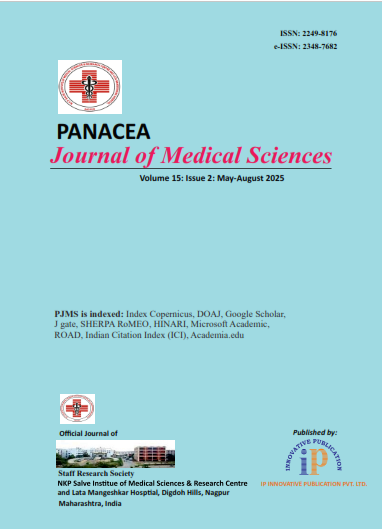Panacea Journal of Medical Sciences
Panacea Journal of Medical Sciences (PJMS) open access, peer-reviewed triannually journal publishing since 2011 and is published under auspices of the “NKP Salve Institute of Medical Sciences and Research Centre”. With the aim of faster and better dissemination of knowledge, we will be publishing the article ‘Ahead of Print’ immediately on acceptance. In addition, the journal would allow free access (Open Access) to its contents, which is likely to attract more readers and citations to articles published in PJMS.Manuscripts must be prepared in accordance with “Uniform requiremen...

An observational study to evaluate Loss To Follow-Up (LTFU) rate and treatment outcomes of pulmonary tuberculosis patients in the Dehradun district
Page: 269-274
Introduction: Tuberculosis case detection, treatment adherence, and treatment outcomes have significantly improved over the past decade. However, it is essential to identify the ongoing barriers at both grassroots and programmatic levels to enhance these areas, enabling India to move closer to its goal of TB elimination by 2025.
Aim and Objective: This study evaluated the loss to follow-up (LTFU) rate and treatment outcomes among pulmonary tuberculosis patients in the Dehradun district.
Materials and Methods: an observational study carried out using secondary data gathered from tuberculosis patients reported in the Dehradun District during three years (2018-2020). The data collected was analyzed to evaluate treatment results and treatment adherence of the pulmonary tuberculosis patients.
Result: - Among study participants, LTFU rate increased in Chakrata, Dehradun, and Rishikesh in 2020, likely attributed to challenges posed by the COVID-19 pandemic. In contrast, Kalsi exhibited consistently lower loss rates and relatively high positive outcomes, suggesting it could serve as a model for other treatment units. The decline in positive outcomes during the year 2020 at various Tuberculosis Units is in alignment with decreased TB case notification and increased LTFU rates, likely a result of disruptions in the healthcare system and restricted access to tuberculosis services during the pandemic.
Conclusion: The improvement in NTEP indicators, such as tuberculosis treatment adherence and treatment outcomes, indicates that the program is progressing in the right direction. Nevertheless, it remains crucial to address programmatic gaps and expedite efforts in alignment with the national goal of TB elimination by 2025.
Article Metrics
- Visibility 15 Views
- Downloads 6 Views
- DOI 10.18231/pjms.v.15.i.2.269-274
-
CrossMark
- Citation
- Received Date March 01, 2025
- Accepted Date April 23, 2025
- Publication Date August 19, 2025